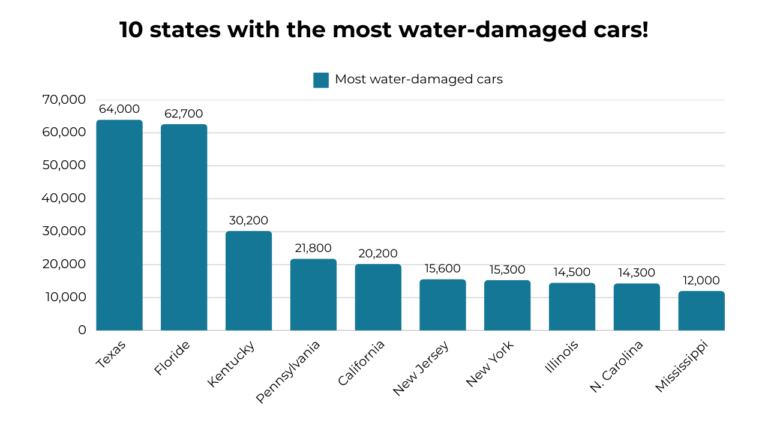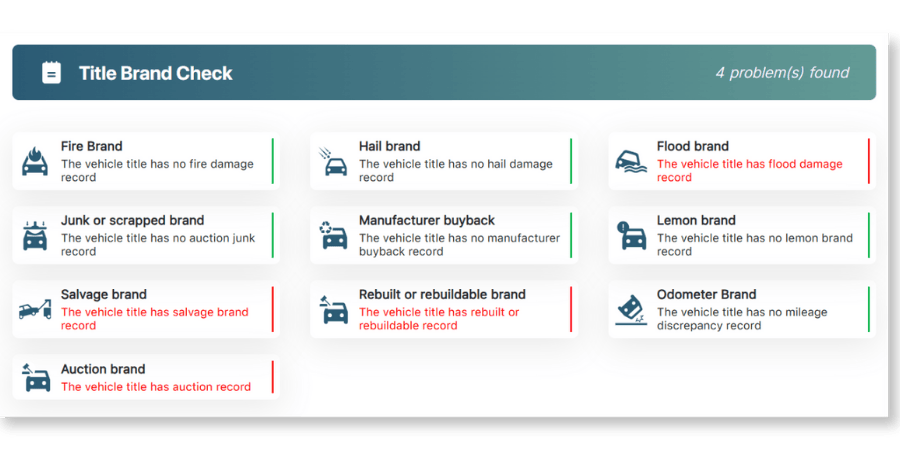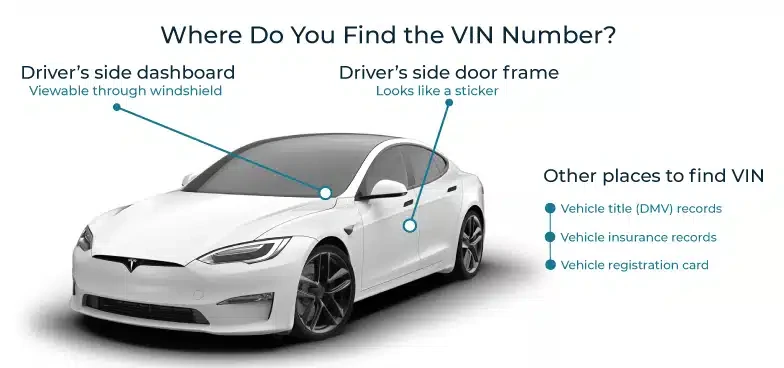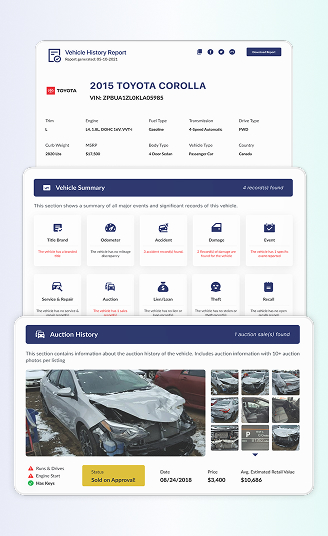Flood Vehicle Check
More than 100,000 cars are affected by flood every year in the U.S. Before buying a used car especially in Texas or Florida, it’s crucial to perform a flooded car VIN check to avoid ending up with a flood damaged vehicle.
How to Spot a Flood Damaged Car
If you are physically inspecting a used car, you should check for the following signs of a flood damaged car:
- Unusual odors (musty or moldy smell).
- Sand or dirt in unusual areas like the glove compartment, and under the seats.
- Rust and moisture on the underside of the car.
- Smoke and strange noises during the test drive.
- Loosed, stained or new upholstery or carpeting.
- Fog in the interior or exterior lights.
- Faulty or malfunctioning electronics.
Still in doubt? Double-check within seconds by running a flood VIN check for any reported flood damage, salvage title or other hidden issues.
Flood Damaged Cars By States

Why Run a Flooded Car VIN Check?
Floods have damaged many cars in the U.S. recently. In 2024, over 347,000 vehicles were flood-damaged during hurricanes, including Hurricane Helene and Hurricane Milton. Checking a car’s VIN reveals if it has flood damage.
Flooded cars may have hidden issues like rust or electrical problems, which can be dangerous and costly to fix. Some sellers try to hide flood damage to sell cars quickly.
A flooded car VIN check helps you avoid buying a damaged car- a simple step to protect your safety and money. Always check the VIN before purchasing a used car.
Flood Vehicle Check Sample Report
Here is an example to give a clear picture of what the flood VIN check report looks like.

The title brand check section provides a detailed overview of the vehicle’s history, revealing damage such as flooding. It identifies title issues, highlighting risks like salvage, flood, rebuilt, or auction brands in red. Green indicates no issues, such as fire, hail, or odometer discrepancies. The summary at the top lists four problems, clearly outlining areas that need attention.
Tropical storms from June to July 2024 damaged approximately 89,000 cars. That number only adds to the more than 400,000 flood damaged vehicles that returned to the road in 2023. Those numbers don’t include the car damaged by the hurricane, though. That’s scary, isn’t it?
Common Problems with Flooded Cars
Some water-damaged cars can be repaired and sold in another state, so it’s important to check flood risk and inspect any car thoroughly before buying it. Here are some common problems with flooded cars:
Hidden Structural Problems
Water damage is a serious issue that can affect a car in many ways. It can corrode the frame, weaken welds, and damage the electronic system, which could be dangerous if left unfixed. Water can also harm the car’s mechanics, electronics, and lubricant system.
Over time, corrosion may spread to critical components, including the airbag system, making the car unsafe to drive.
Muddy water can clog important vehicle parts, such as the differential, axles, and transmission, disrupting the car’s performance. Once the muddy water reaches that part of the car, be ready for a costly repair. This problem might take months or even years to appear and is hard to detect.
For example, muddy fluid in the rear differential can cause severe damage over time. Once it reaches that point, the car may receive a salvage title, meaning the repair cost will be higher than its value.
Costly Repairs and Restorations
When you see a used car sold below its market value, it might be an early warning of hidden damages, including flood damage.
If you are unsure about the condition, you can check the car’s title to see if it has been assigned a salvage title. For your consideration, insurance companies often write off flood-damaged cars, giving them a salvage title.
Changing a salvage title back to a roadworthy condition takes time and can cost money. This process often includes fixing the structural damages, replacing broken electronics, damaged wires and parts, and fixing issues with the car’s oil system. Additionally, the vehicle must pass strict inspections to change from a salvage title to a rebuilt or reconstructed one.
Electrical Issues
When water finally reaches the car’s electrical panel, it can seriously damage the system, including the wires and sensors. Broken systems can lead to intermittent or complete failure and affect other systems, such as airbags, brakes, and engine control. If these issues are not resolved quickly, they can affect the car’s performance and pose significant risks to the driver and passengers.
Health Hazards from Mold and Mildew
Flooded cars often develop mold and mildew in hidden areas such as the upholstery, carpet, and air vents. If water seeps into the interior, it could create a damp environment, allowing mold to grow over time. This can result in a foul odor and visible mold patches in the seat and other parts of the interior.
Mold and mildew are more than just an aesthetic issue; they pose serious health risks. Breathing in mold could trigger severe allergies, asthma, or other respiratory problems.
Look closely at the seats and hidden places for signs of mold or mildew. If you see a mold patch anywhere, it may be a sign that the car has ever been flooded.
Deceptive Resale Practices
Sellers and dealers often try to disguise the damages in a flooded car to make the vehicle appealing to buyers. Flooded cars often get meticulous detailing to conceal any sign of water damage.
However, polishing and brushing don’t fix all the problems caused by flooding. Corroded wiring, damaged sensors, and mold growing in hidden areas often go undetected until the vehicle is sold.
If you are unaware of these issues, you might discover them later, which could cost them a lot to repair, not to mention the health and safety concerns.
Reduced Resale Value
Once a car has been flooded, the resale price for the car becomes less appealing than for healthy cars; prices could drop significantly. Flood damaged vehicles are a major red flag for buyers, as they will have long-term issues such as corrosion, mold, electrical issues, and more.
The industry reports that a flood-damaged vehicle can lose up to 25% of its original MSRP compared to a similar car without damage; however, this depends on the extent of the flooding and the repairs made.
Large gaps between a car’s MSRP and listed price can be early signs of hidden damage. If the deal seems too good to be true, getting a flooded car VIN check might be a good idea.
How to Check for Flood Damage on a Car
Follow these simple steps to check vehicle for flood damage:
- Enter the VIN or license plate to the form above.
- Click on ‘Search VIN’ to reveal the title status of the car.
- Preview the vehicle history report. Here, you’ll see all the title statuses tied to the car.
- Proceed to payment to access the full vehicle history.
Frequently Asked Questions
How to check for flood damage on a car
To check vehicle for flood damage, simply use our reliable flood risk check tool to obtain detailed information about the vehicle history and title brands and condition.
If My Car Was Flooded, Is It Totaled?
A flooded car is often considered totaled if the repair costs exceed its market value. Flood damage can ruin car systems, such as electronic systems, and cause mold and mildew to grow in hidden places. The insurance company usually declares such cars a total loss and assigns them a salvage title. To avoid buying a vehicle unknowingly, simply run a carfax flood check to reveal any record of flood or other damage.
If My Car Was Flooded, Will Insurance Cover It?
Complete coverage usually covers the damage caused by floods. However, the insurance won’t cover the water damage if you only have basic coverage. Always check the insurance coverage or consult with the agent to understand what’s included and not included in your insurance plan.
Are flood damaged vehicles repairable?
Some flood damaged vehicles can be fixed, but it depends on how bad the damage is and what type of water was involved. If dried quickly, small damage might be repaired, but badly flooded cars are usually too costly to fix.


